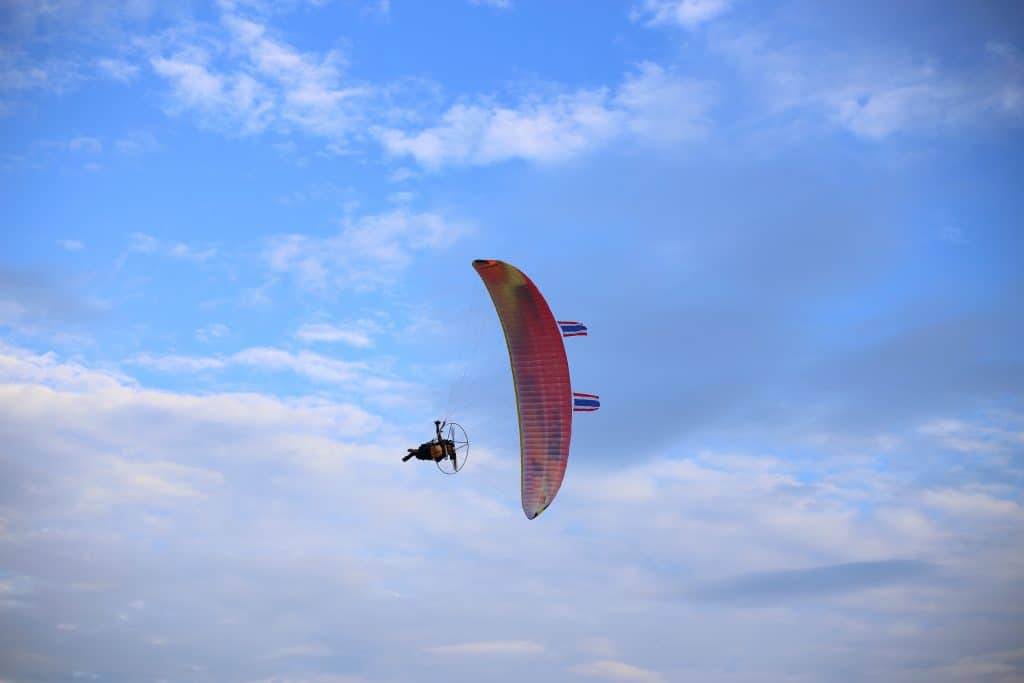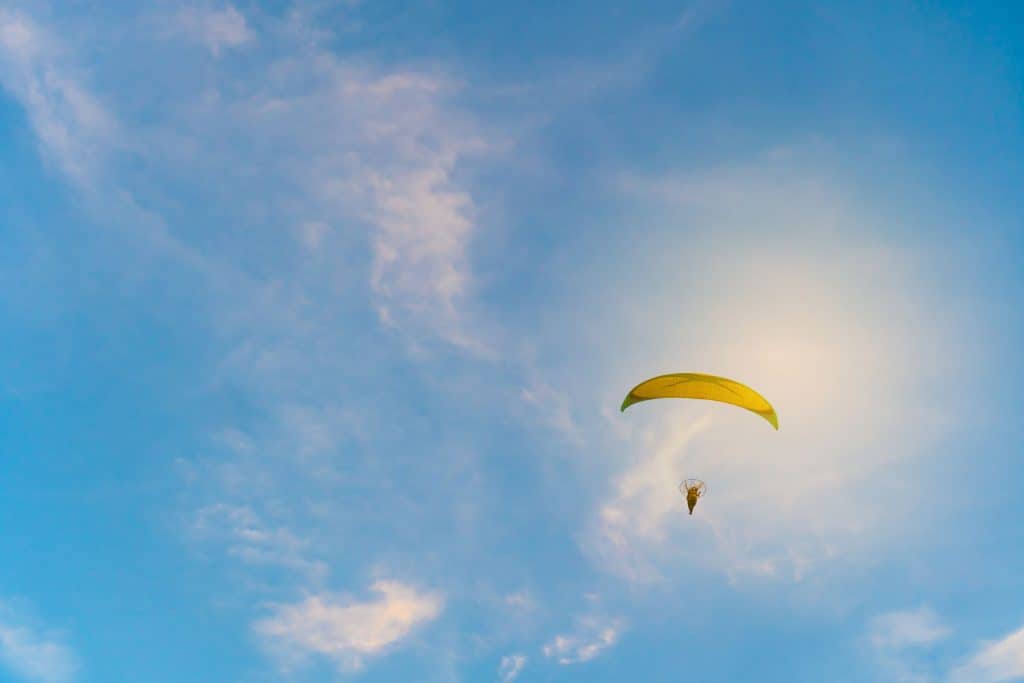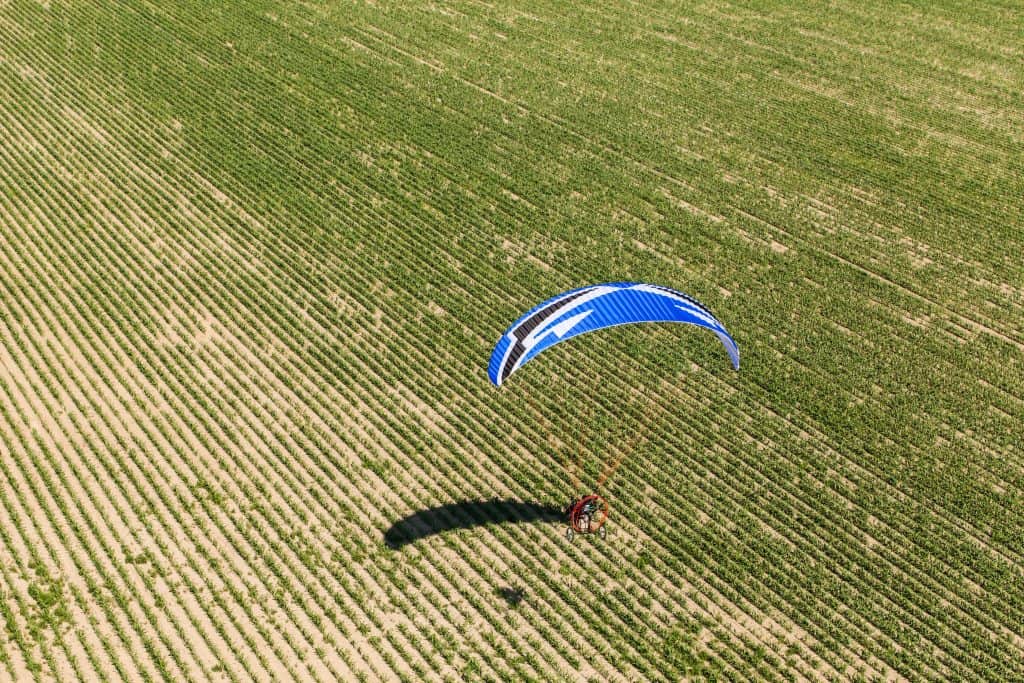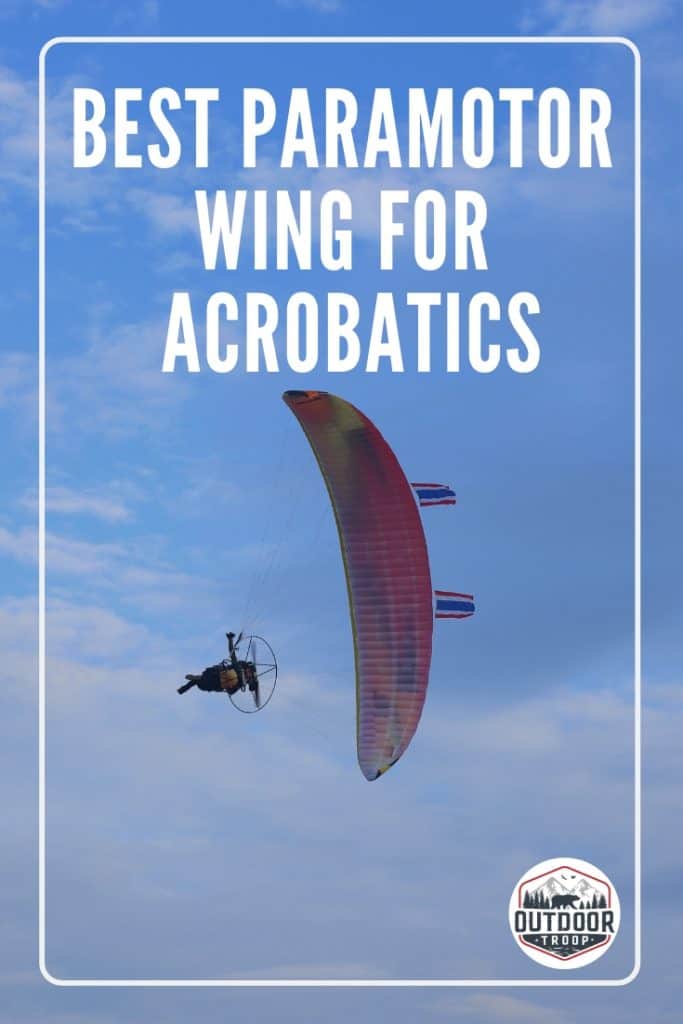
Have you been in the paramotoring world for a good long time, and want to take your game to the next level? Do you enjoy doing tricks in the air, but don’t know what wing to get to help you in your daredevil endeavors? It can be confusing when you’re trying to find the wing for you, as there are so many wing choices. Which one should you choose?
So, what is the best paramotor wing for acrobatics? The best paramotor wing for acro is the Nikita 5, which is produced by ICARO paragliders. The small, light design is incredibly intuitive, the unnatural stability that this paramotor wing can have due to its response time, and it’s many finely-tuned details lift it above the rest of the crowd.
Though the Nikita 5 is our suggestion, there are many other paramotor wings that have stellar qualities and may suit your needs better. Let’s talk a bit about what constitutes a standard/decent paramotoring wing when you’re trying to fly acro.
What Makes a Wing good for Acro?
The thing that makes a paramotor wing good for acro is its ability to turn and move quickly. There are some special features of certain acro paramotors, but there are some things that are common between them that add to this ability to turn quickly.
Sizing of Wing
Often times, pilots will learn to fly on larger wings. These large wings are good for beginners because larger wings are far more stable than smaller wings. Larger wings are less susceptible to the turbulent winds that you come across as a pilot.
Large wings definitely have their place, but they are not something to stick with once you are more experienced.
Larger wings are difficult to do acro with, just because of how automatically stable they are. It’s like trying to do a wheelie on a bike with training wheels. The design is keeping you from doing the very thing you are trying to do.
Smaller wings are less safe but are far more maneuvrable than large wings. As a more experienced pilot flying a smaller wing, you should be able to more easily manually deal with winds, despite the fact that you are flying a smaller wing.
Once you have gotten a bit of experience under your belt, a smaller wing, though more dangerous, is the next step for you to grow as a pilot.

Responsiveness of the Wing
When I talk about the responsiveness of the wing, I’m talking about the reaction time the paramotor has when responding to the inputs of the pilot. Some paramotors will have slower response times.
This usually comes with safer, non-acro paramotors. Slow response times leave time for the paramotor to make the transitions easy and smooth.
With acro paramotors, the response time is automatic. It’s up to you, the pilot, to make sure that the turns, transitions, and tricks you may try to pull off go smoothly. As the pilot, you have to be confident in your abilities to fly these paramotor wings.
With this increase in ability, there is more opportunity to fail and make costly mistakes. Like Uncle Ben said, “With great power comes great responsibility.” Be sure that you can handle the responsibility, and are confident in your flying ability when you fly these wings.
Material/Weight of Wing
The material of the wing is another important thing to consider. Wings with thicker material will not have the same reflexive ability as wings that are made of lighter, thinner material.
The thinner material is good for acro because it is far more reactive to the pilot’s needs in the moment than the thicker material.
Don’t get a wing that is overly thin, it still needs some durability. But get a wing on the more light weight side. It helps with acro.
Dynamic Control of the Wing
When I say dynamics, I mean the potential energy that can be released from the glider. The speeds that the wing is capable of handling and manipulating are important, especially when it comes to acro.
For some maneuvers, you need to be moving at a good clip to pull them off. If you can’t keep complete control of a wing at those high speeds, it makes it difficult to pull off those moves.
Now that we know the important things that are needed in a wing for it to be considered an acro wing, we can take a look at some different acro wings. You can decide which of these wings you think is the best wing for yourself. I’ve provided links to the manufacturers/providers of these wings.

The Best Wings for Acro
Nikita 5
Click the link here to learn more about the Nikita 5.
Description:
The paramotor at the top of this list, the Nikita 5 can be described as a stable wing that can smoothly handle rhythmic maneuvers, infinity maneuvers, and anti-rhythmic maneuvres smoothly and without any hard blows.
It has sharp steering capabilities to quickly go from one maneuver to the next. The intuitive nature of the Nikita 5 doesn’t stop there though. The brake pressure is medium-hard, with very precise pressure detection for when you are pulling even slightly on the brakes.

If you fall into it’s lower weight range of paramotorists suggested for the Nikita 5, you have the capability to wait and decide your next maneuver. If you are on the upper end of the weight range, you have insane amounts of potential for speed and power behind your movements as an acro professional.
One cool addition to this wing is the valves that ICARO, the manufacturer of the Nikita 5 decided to add. With new valves embedded in the cross ports, a twister maneuver can be initiated by the pilot and carried out in seconds. Literally built from the ground up for paramotoring, this wing is possibly the best wing for acro paramotoring out there.
Stats:
| NIKITA 5 17 | NIKITA 5 18 | NIKITA 5 20 | |
| Wing Span (m) | 7.7 | 7.9 | 8.35 |
| Weight of Wing (kg) | 5.2 | 5.4 | 5.8 |
| Material of Wing | SKYTEX 38 | SKYTEX 38 | SKYTEX 38 |
| Flat Area (m2) | 17 | 18 | 20 |
Third Party Rating(s):
Currently Uncertified
My Opinion:
The Nikita 5 is the perfect paramotor wing for those paramotorists who have the talent to take their skills to the next level.
The Nikita 5 has a rather light wing, but what’s more impressive is the fact that this wing is only around 9-10 meters. Most paragliding/paramotoring acro wings are around 10-11 meters. How they got this wing this small will continue to baffle me for a long time.
Something that many people online have to say about it is how surprisingly stable it is. You can be going at a breakneck speed, and still feel secure when flying the Nikita 5.
“The NIKITA 5 flies precisely and stable. The Esfera runs smoothly and the transitions run clean without hanging back. The Heli runs stable and when soaring on a slope or when Acro flying I love the controllable dynamic of the glider. The NIKITA 5 is a worthy successor to the 4”
Xanda Meschuh, taken from icaro-paragliders.com
For more information on the Nikita 5 from the manufacturer, click here.
Agility
Description:
The Agility paramotor/paragliding wing is a glider for experienced pilots. Specially designed to perform all acrobatic maneuvers, it’s no wonder that the Agility was on the podium twice when their creators Horacio and Théo won the Acro Paragliding World Cup in Synchro and also won gold on the Synchro Aerobatics at the FAI World Air Games in Dubai.
It’s clear that the Agility can perform incredibly in competitions. Its specific combination of stability from the wingspan and acro capabilities from lightweight material of the wing lead to an interesting and wildly different acro paraglider/paramotoring wing from many other acro wings.
Stats:
| Agility 17 | Agility 19 | |
| Wing Span (m) | 10.16 | 11.28 |
| Weight of Wing (kg) | 4.6 | 4.8 |
| Flat Area (m2) | 17.60 | 19.54 |
| Number of Cells | 57 | 57 |
Third Party Rating:
EN Certification- 926-1 (for both Agility 17 and Agility 19)
My Opinion:
The Agility is a lighter wing, slightly lighter than the Nikita 5. This gives a few unique advantages to the Agility. For one, the responsiveness of the Agility will be top notch.
However, it has a wider wingspan than the Nikita 5 by a significant margin. The Agility is good for pilots who want a wing for acro that isn’t as high risk as other acro wings (having the stability that comes with a large wing), while also having the reflexive capabilities that all acro wings have.
Here is a quote from Théo de Blic, one of the creators of the Agility. He has worked on countless wings before, and here’s what he has to say on the Agility.
“Agility has been made to give pure joy to the pilots, whether it is when they are flying downs doing tricks, or thermaling to gain altitude, the glider is a delight. It has a light brake pressure and an instinctive handling, while you fly you have the feeling to fly an XC glider, but it turns straight to an acro glider as soon as you start doing manoeuvres.
Due to its impressive but easy to handle energy and its great internal pressure the glider is able to perform all tricks the cleanest way possible. Whether you are flying waggas, thermalling in light conditions or flying the craziest tricks you know Agility will suits you. I have flown a lot of gliders in my life but Agility surpasses them all.”
Théo de Blic, one of the Creators of the Agility
For more information on the Agility from the manufacturer, click here.
F – Gravity 2
Description:
The F-Gravity 2 is one of the newest freestyle paraglider/paramotoring wings offered by the glider making company Niviuk. The companies site boasts that this is “the glider where every maneuver is possible offering the pilot challenges big or small.” No matter your skill in acro, this wing will suit your needs.
The F-Gravity 2 is ideal for those pilots who are intermediate in their acro skills, and want to progress in paramotor acrobatics. This compact wing will bring the necessary energy and reliability to flying that is needed for training.
That’s not to say that advanced pilots won’t be able to enjoy the F-Gravity 2. The most advanced acro pilots will enjoy the handling of the F-Gravity 2 and will be able to practice freestyle to the highest extent.
Stats:
| F-Gravity 2 20 | F-Gravity 2 22 | F-Gravity 2 24 | |
| Flat Area (m2) | 20 | 22 | 24 |
| Weight of Wing (kg) | 5.5 | 5.8 | 6.1 |
| Wing Span (m) | 10.3 | 10.8 | 11.28 |
| Aspect Ratio | 5.3 | 5.3 | 5.3 |
Third Party Rating:
EN Certification- 926-1 (for the F-Gravity 2 20, the F-Gravity 2 22, and the F-Gravity 2 24)
My Opinion:
One of the most interesting aspects of the F-Gravity is the new and interesting feature that Niviuk has added that they like to call SLE, or “Structured Leading Edge”. It’s exactly what it sounds like.
The SLE provides more rigidity and stability along the span of the leading edge but also allows for full flexibility along both of the vertical and horizontal axis of the open cells.
There are dangers to having a rigid leading edge. In a situation where a wing collapse may occur, the structured leading edge could inhibit this. this may seem like a good thing, but wing collapses are actually a necessary part of paramotoring.
If a wing is kept from collapsing, it’s actually more dangerous than if it doesn’t. A pilot could find themselves falling through the sky wrapped in their wing. This just goes as a testament to how careful one must be when paramotoring and doing acro, especially with this wing.
The rigid edge provides extra stability but also has consequences if do manage to get yourself into a situation where a wing collapse should be imminent.
I would suggest this wing to paramotorists who are very experienced with acro. There are some cool effects that come from the rigid edge, and it’s an all-around great acro paramotor. Just be sure to get comfortable with the wing for a while before you try to pull any acro on it.
For more information on the F- Gravity 2 from the manufacturer, click here.
Gangster 2
Description:
The Gangster 2 is a glider with a ridiculous amount of agility but still sits in a comfortable safety margin. One of the lighter gliders on this list, it has the reaction time of a lightning bolt, and with a typical acro wingspan, it’s safer than most of the other gliders on this list as well.
The Gangster 2 has a dynamic feel to it. Brake inputs translate quickly and precisely into motion. SAT’s, helicopters, and big wing-overs are a breeze with the Gangster 2.
The Gangster 2 also has vents that span between the B/C and C/D lines in the center of the wing. This helps to enhance the internal pressure during negative maneuvers.
Stats:
| Gangster 2 20 | Gangster 2 22 | |
| Flat Area (m2) | 20 | 22 |
| Wing Span (m) | 10.58 | 11.1 |
| Weight of Wing (kg) | 4.4 | 4.7 |
| Aspect Ratio | 5.6 | 5.6 |
Third Party Rating:
EN Certification- 926-1; EN C
My Opinion:
This wing has a lot going for it. It’s light, has a good acro wingspan, and has some solid design features including the vents to help control pressure.
The Gangster is ideal for freestyle and wagga. Playing around obstacles is effortless and fun, and despite the dynamic feel of the Gangster 2 it’s still got a comfortable safety margin.
When it comes to maneuvers, deep stalls are easier to achieve and the glider shoots less during recovery. While some freestyle wings can be tough to climb with, the Gangster is optimized for vertical movement.
The Gangster 2 is a solid choice for anyone who wants to get into acro.
For more information on the Gangster 2 from the manufacturer, click here.

